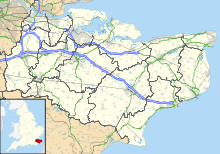St. Margaret's Church, Rochester
| St Margaret's Church, Rochester | |
|---|---|
| Parish Church of St Margaret of Antioch | |

East end in winter, viewed from St. Margaret's Street
|
|
| Coordinates: 51°23′06″N 0°29′58″E / 51.384970°N 0.499439°E | |
| OS grid reference | TQ 74019 68065 |
| Location | Rochester, Kent |
| Country | England |
| Denomination | Anglican |
| Website | www.parishofrochester.org.uk |
| Architecture | |
| Status | Chapel of Ease |
| Functional status | Active |
| Heritage designation | Grade II* |
| Designated | 24 October 1950 |
| Architectural type | Church |
| Specifications | |
| Materials | ragstone (tower) and rendered brick (church) |
| Bells | 8 (full circle) |
| Tenor bell weight | 9 long cwt 2 qr 8 lb (1,072 lb or 486 kg) |
| Administration | |
| Parish | St Peter with St Margaret |
| Deanery | Rochester |
| Diocese | Rochester |
| Province | Canterbury |
| Clergy | |
| Vicar(s) | Rev Dr Joel Love |
| Laity | |
| Churchwarden(s) | Pam Moss, Peter Cornell |
St Margaret's Church, Rochester is now a Chapel of Ease within the parish of St Peter with St Margaret, Rochester. Previously it was the parish church of St Margaret's Without (that is, outside the city walls of Rochester). Thorpe records it as having previously been called St Margaret's in Suthgate. The building is a Grade II* listed building, English Heritage number 173172.
The first record of St Margaret's is in an 1108 charter of Bishop Gundulf. From the time of Bishop Gundulph until the appointment of William Talvez in 1272 as Vicar, St. Margaret's was a chapel of the parish of St. Nicholas. There was at that time no separate parish church of St. Nicholas, instead the parochial altar was housed in the nave of Rochester Cathedral. From this dependency Wheatley has suggested that St. Margaret's was a chapel of ease to the Cathedral, but the Cathedral itself was never a parish church.
During the reign of King Richard I (1157–1199), bishop Gilbert de Glanville gave the church to his hospital in Strood. After several appeals to the pope the monks of Rochester regained control of it in 1255. The early vicars, up to 1401, received only a yearly stipend from the convent. A settlement in that year endowed the church and established a vicarage and lands for the support of it. In 1488 the convent finally relinquished control, the bishop reserving to himself episcopal rights. In 1540, during the reformation, the church was surrendered into the King's hands and subsequently settled on the newly founded Dean and Chapter of Rochester.
The earliest, and only medieval, part of the building is the tower which was either constructed or restored in 1465. The medieval church consisted of a nave and two chancels to the south of the nave, of this nothing remains. During the reign of Charles II of England (de facto 1660–1685) a coronet "set round with precious stones" was dug up in the churchyard. It was supposed locally that a Saxon King had been buried there.
The original parish was rural, stretching from the city walls of Rochester in the North to Borstal in the South. During the 18th and 19th centuries the City of Rochester expanded South into the parish. Expansion of Rochester to the North and West is blocked by the River Medway and to the East by Chatham. The medieval church became inadequate for the growing population and in 1823 rebuilding started. The nave was complete the following year, the original chancel, tower and side chapels being retained. With the exception of the tower the medieval buildings were demolished a few years later and by 1840 the basic fabric of the present building was complete. A new East window was installed in 1872.
...
Wikipedia

